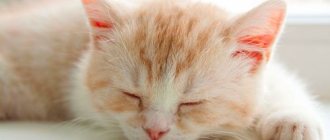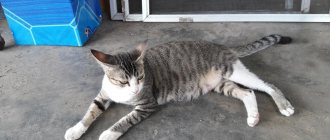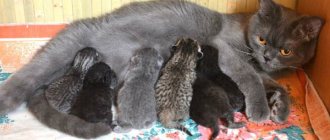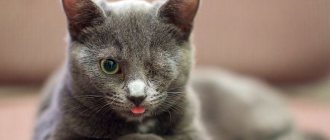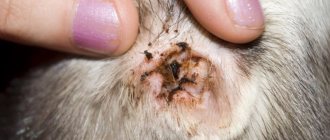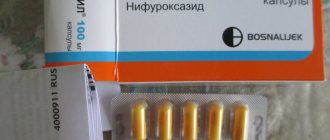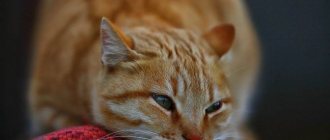Description of the disease
To put it simply, this is not one disease, but several, i.e.
complex of diseases. But they all lead to disruption of its contractile function. It follows from this that they lead to impaired blood circulation throughout the cat’s body. It is worth taking this as seriously as possible, because the animal’s body is literally balancing “on the brink.”
In critical cases (that is, this is not always the case), the “power” of the heart is only enough to supply tissues and organs with oxygen and various nutrients only in a calm state.
It's terrible, but when he comes out of this state, for example, he starts jumping and running, he shows signs of asphyxia.
Important!
It is worth noting that heart failure in cats (unlike in humans) is uncommon.
The fact that this phenomenon is rare is due to the biochemistry of cats. More precisely, their body. This was also linked to the nutritional characteristics of cats. Most often, the described disease develops in animals that are at least 6 years old.
But, unfortunately, there are exceptions. Sometimes this diagnosis is made at the age of one and a half years. This happens in cases with a congenital defect.
Etiology
Why can such a dangerous condition still occur in cats? What are the reasons? First of all, the disease can be caused by congenital and acquired heart defects; cardiomyopathy, as well as arterial hypertension, are to blame. It is important to note that for competent and effective treatment, it is extremely important to find out the cause of the pathology in each specific case, since therapy can vary significantly. Often, failure develops against the background of acute or chronic myocarditis (inflammation of the heart muscle). The same cases include myocardosis, when dystrophic, degenerative processes develop in the cardiac tissue. In both of these cases, the organ cannot provide normal blood circulation, and therefore the cat inevitably begins to have health problems.
Oddly enough, chronic heart failure in a cat may well be caused by... hyperthyroidism. To keep it simple, this is the name of a disease of the thyroid gland, in which it produces more hormones. What is the relationship here with the condition of the heart? The most direct! The fact is that due to the increased content of thyroid hormones in the blood, the animal experiences constant, chronic tachycardia. Because of this, hypertrophy of the left ventricle develops, which leads to a decrease in the volume of blood ejected per contraction. In addition, such a rhythm of work simply wears out the heart muscle, which is why the cat’s body certainly does not become healthier. Finally, mention should be made of birth defects.
Symptoms
They are not obvious all the time.
Classic symptoms include shortness of breath, fatigue and fainting. The majority of cats lead a sedentary lifestyle, so these symptoms are often invisible to the owners. Especially if they belong to the category of always busy people.
Most often, the first symptom that the owner notices is pulmonary edema. That is, severe respiratory failure.
Another symptom of this disease is paralysis of the hind legs. Its cause is thromboembolism of the abdominal aorta.
Help with fainting
Fainting itself is a very serious symptom in cats.
Most often, this means that the brain vessels do not have enough blood. Symptoms of fainting: sudden fall, nausea, weak, thready pulse.
And, of course, in this state the animal stops reacting to anything. Including your own nickname.
How to help an animal?
- Provide fresh air and free breathing.
- Place ice in a bubble and a handkerchief soaked in water on your head.
- The head and body need to be watered.
- The animal must be placed, the back part should be placed higher than the front (meaning the limbs and head).
- This will allow more blood to flow into the brain, and the fainting will go away.
- When the cat comes to its senses, you must give it something to drink. If she cannot drink on her own, you need to pour water into her cheek in small portions.
- After everything is over, the animal needs to be allowed to rest. Drink sweet, strong, lukewarm tea.
- You can feed her no earlier than an hour to an hour and a half after she comes to her senses.
Acute heart failure in cats
In humans, it occurs if the blood supply to the myocardium is severely disrupted.
In cats, unlike them, there is no main provoking factor. This feature lies in their diet. It does not clog blood vessels, unlike human food, with cholesterol plaques. Most often, this disease occurs due to an imbalance of the nervous and endocrine systems. Due to stressful situations.
Reference!
The most stressful (and deadly) veterinary procedure is declawing surgery.
What should you do if the above symptoms appear?
You should contact a specialist, and without delay. If the disease has not yet progressed far, in 85% of cases the animal will survive. A cardiologist will perform an examination for animals (the nature of diseases of the left and right atria is different and affects the appearance), along the way, he will do an echocardiogram and an X-ray of the cardiac area, draw blood for tests, and evaluate the fundus of the eye.
In some cases, a specific method is used - cardiac catheterization, when a flexible tube is inserted into the cardiac cavity to assess the anatomical and functional state of the septa and walls of the organ.
Sometimes physical examinations, auscultation (an informative and diagnostic method of heart pathologies) and standard percussion are required. They make it possible to detect an increase in the boundaries of an organ and identify noises without the use of expensive procedures. Once the diagnosis is confirmed, therapy is prescribed, which may depend on the degree of the disease, cardiac changes, and blood flow.
The owner will have to independently record changes in the condition of his cat, and here it will be enough to count the number of breaths that the animal takes at rest.
If the cat is sleeping, you need to note the time (a minute) and monitor the number of breaths (raising the sides). Breathing movements should be counted several times a day. Then write them down and transmit the results to the veterinarian, who will be able to monitor the patient’s health over time. Heart disease in cats is initially characterized by nonspecific signs that interfere with diagnostic measures.
The reasons leading to damage to the heart muscle by various developmental mechanisms are:
- Arrhythmia;
- Heartworm infection;
- Action of infectious agents;
- Valve pathologies – atresia, aplasia or stenosis;
- Incomplete relaxation or insufficient compression of the myocardium;
- Vascular pathologies, due to which resistance to blood flow increases;
- Shunts between the heart chambers.
Heart failure is prone to development if one or more of the above factors are present. When there is insufficient blood flow, the phenomenon of congestive heart failure occurs.
Causes and diagnosis
Causes
The reasons may be as follows:
- Congenital heart pathologies. They are very rare in cats. In approximately 2% of all cases.
- Diseases of the heart muscle caused by infections.
- Heartworms (yes, there are such types of worms), their larvae are found in mosquitoes. When a mosquito bites a cat, they enter the bloodstream. They then settle in the pulmonary artery. They can reach up to 30 cm! Because they are present in the circulatory system, they fundamentally interfere with the outflow of blood and cause enormous damage to the arteries. Adult worms literally entangle the heart, preventing it from working. These pests can only be identified using a blood test.
- Cardiomyopathy, it is caused by an inadequate diet in cats. Usually, pets do not have enough taurine. It is found in meat and raw fish. Is it possible to feed a cat boiled fish or meat? It’s possible, but she still won’t get the right amount of taurine. When cooked, this substance is destroyed.
- Metabolic disease. Sometimes it is caused by an incorrectly structured diet.
- Age-related changes. Heart failure most often occurs in cats over 6 years of age.
Diagnostics
It must be carried out by a qualified veterinarian - a cardiologist in order to prescribe the correct treatment.
Typically it includes:
- blood analysis;
- urine;
- ECG;
- chest x-ray.
It goes without saying that if a cat is diagnosed with this, it must be excluded from planning for breeding offspring.
Establishing diagnosis
In cats, timely diagnosis is very rare. Most often, this happens when the signs of heart failure increase so much that the body can no longer compensate for the improper functioning of the heart with oxygen starvation of the cells. It is impossible to independently diagnose this type of pathology, because This requires a number of additional examination methods:
- thorough examination of the animal, careful listening to heart sounds;
- detailed survey of owners and medical history;
- cardiogram;
- ultrasonography;
- X-ray;
- blood chemistry.
Only after analyzing the results of all the studies conducted can we draw conclusions about possible problems in the functioning of the cardiovascular system!
Treatment
How to treat a cat with heart failure?
- Provide the animal with complete rest. You need to protect him from absolutely any stress. Be it a trip in public transport, the arrival of guests, or even a running vacuum cleaner.
- Treatment with diuretics. But only those approved by the veterinarian. They will remove excess fluid from the body. During the course of the disease, it accumulates near the lungs and causes swelling. More precisely, it can cause. Fluid may also accumulate in the chest, causing pleurisy. It can also be in the abdominal cavity and cause ascites. What happens if the amount of fluid in the body decreases? The load on the heart will also decrease.
- It is very important that the diet is balanced.
- Treatment with ACE inhibitors. These medications reduce the workload on the heart. And they increase blood flow.
- If fluid has collected around an organ, the veterinarian will drain the fluid. The cat will feel relief. Unfortunately, not for long. How is this procedure carried out? A sterile needle is inserted into the desired location.
Heart medications for cats
The following heart medications for cats can be used in veterinary practice:
- Diuretics include cheap and effective furosemide and diacarb.
- Enalapril, Ramipril, Benazepril are used as ACE inhibitors in veterinary medicine.
- Adrenaline can be used to stimulate cardiac activity in the first hours after an attack; subsequently, caffeine-sodium benzoate is used (it is much safer and “softer”).
- Pimobendan is prescribed as a cardiotonic.
Prevention
The most important prevention is changing the animal’s lifestyle to a more active one.
If a cat does not eat properly and, as a logical consequence, suffers from obesity, these are the main enemies for her heart. Therefore, an attentive owner should also ensure that the cat has plenty of healthy (!) food.
If a cat does not eat properly and, as a logical consequence, suffers from obesity, these are the main enemies for her heart.
Also, for prevention, after acquiring (or if the owner found it or took it for free, but after this acquisition), the pet must be examined at a veterinary clinic; in case of any risk, the cat must be checked at least once a year.
Attention!
Cats with a “sofa” lifestyle are more likely to develop diseases such as heart failure.
Treatment consists of drug therapy, which will make the heart work easier, eliminate pain, improve blood circulation, and also nourish the myocardium, since, unfortunately, heart surgery is not performed in cats.
Heart attack in a cat: first aid
Heart failure and cardiac arrest is one of the most dangerous conditions of the body, in which seconds count. If a cat has a heart attack, first aid includes two main actions - chest compressions and artificial respiration. Here's an algorithm on how to do it:
- The cat must be laid on its side, right or left - it doesn’t matter.
- One hand secures the animal behind its back.
- The fingers of the second hand are located above the heart, in the region of the 4th–5th intercostal space. You can try to count this place along the ribs, or you can simply place your fingers deep under the front paw. At the same time, grasp the animal's chest so that the thumb is at the bottom and the rest at the top, or use the index, middle and ring fingers to apply pressure from above. Sometimes, in larger cats, it is possible to apply both hands (one palm on top of the other).
- Next, it is necessary to perform rhythmic pressure at a speed of 100–120 times per minute, so that the chest is compressed by approximately 30% when pressed.
- Apply artificial respiration every 30 compressions. To do this, you need to wrap your fingers around the animal’s muzzle and forcefully inhale air into the cat’s nose.
If the owner of a sick animal orients himself correctly and begins performing cardiopulmonary resuscitation before the veterinary service arrives, there is a chance to prevent the cat’s death from a heart attack. Unfortunately, resuscitation without timely medical assistance does not always lead to the desired result, but can give hope for salvation.
Of course, some diseases (terminal stage of the disease, heart rupture in a cat due to injury, etc.) will not allow the heart to beat again, therefore the possibility and feasibility of resuscitation of the animal, even in a clinic, should be discussed in advance with a veterinarian.
First aid from the owner
The first thing to do if you suspect a heart attack is to call your veterinarian. According to the symptoms described by the owner, he will recommend giving the animal Corvalol or another drug.
IMPORTANT! You should not give any medications without a doctor’s instructions, otherwise your pet’s condition will only worsen!
What to do next:
- Provide the cat with complete rest - do not shift him or disturb him, do not make noise near him.
- The room in which the patient is located should be well ventilated; extreme heat and stuffiness should not be allowed.
- It is highly advisable to have a veterinarian come to your home. If this is not possible, ONLY use a carrier with a hard plastic bottom.
- Do not give water or food to the patient; if the veterinarian recommends any medications over the phone, give them strictly in liquid form or in the form of an injection.
Remember that you can’t help anything at home, so you definitely need to show the sick person to a specialist.
Diagnostic procedures
Timely diagnosis of heart failure is extremely important, because if the causes of the disease are not determined in time and special medications are not selected, fluid accumulates in the lungs, and other dangerous complications are possible, including cardiac arrest. If there is a problem, it is recommended to show the cat to a veterinarian-cardiologist, who will examine the pet and select treatment. To make a final diagnosis, the following diagnostic measures are required:
- laboratory tests of blood and urine;
- ultrasound diagnostics;
- x-rays of the sternum;
- electrocardiography (ECG), during which angina and other heart problems are determined.
What should you do if the above symptoms appear?
You should contact a specialist, and without delay. If the disease has not yet progressed far, in 85% of cases the animal will survive. A cardiologist will perform an examination for animals (the nature of diseases of the left and right atria is different and affects the appearance), along the way, he will do an echocardiogram and an X-ray of the cardiac area, draw blood for tests, and evaluate the fundus of the eye.
In some cases, a specific method is used - cardiac catheterization, when a flexible tube is inserted into the cardiac cavity to assess the anatomical and functional state of the septa and walls of the organ.
Sometimes physical examinations, auscultation (an informative and diagnostic method of heart pathologies) and standard percussion are required. They make it possible to detect an increase in the boundaries of an organ and identify noises without the use of expensive procedures. Once the diagnosis is confirmed, therapy is prescribed, which may depend on the degree of the disease, cardiac changes, and blood flow.
The owner will have to independently record changes in the condition of his cat, and here it will be enough to count the number of breaths that the animal takes at rest.
If the cat is sleeping, you need to note the time (a minute) and monitor the number of breaths (raising the sides). Breathing movements should be counted several times a day. Then write them down and transmit the results to the veterinarian, who will be able to monitor the patient’s health over time. Heart disease in cats is initially characterized by nonspecific signs that interfere with diagnostic measures.
The reasons leading to damage to the heart muscle by various developmental mechanisms are:
- Arrhythmia;
- Heartworm infection;
- Action of infectious agents;
- Valve pathologies – atresia, aplasia or stenosis;
- Incomplete relaxation or insufficient compression of the myocardium;
- Vascular pathologies, due to which resistance to blood flow increases;
- Shunts between the heart chambers.
Heart failure is prone to development if one or more of the above factors are present. When there is insufficient blood flow, the phenomenon of congestive heart failure occurs.
